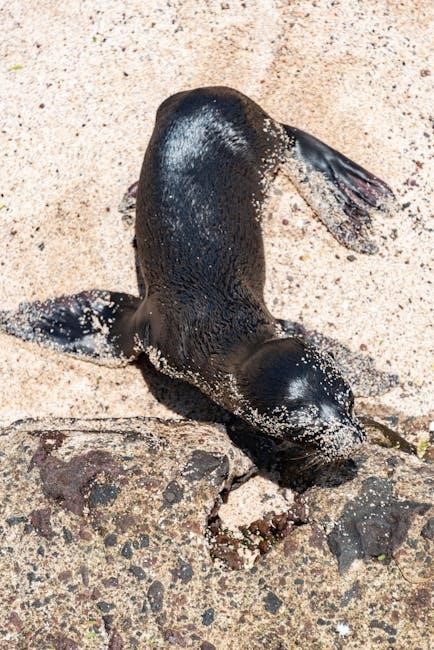
navy seal fitness pdf
Navy SEAL fitness programs are renowned for their intensity and effectiveness, focusing on building strength, endurance, and mental toughness. The Naval Special Warfare Physical Training Guide (PTG) offers a structured 26-week program designed to prepare individuals for the rigors of SEAL training. These guides emphasize proper form, gradual progression, and holistic fitness, making them accessible to aspiring operators worldwide.

1.1 Overview of Navy SEAL Training
Navy SEAL training is a rigorous and highly structured program designed to prepare individuals for the demands of special operations. The Naval Special Warfare Physical Training Guide (PTG) outlines a 26-week program tailored to build strength, endurance, and mental resilience. This comprehensive guide is divided into phases, each focusing on specific aspects of physical conditioning, such as strength training, cardiovascular endurance, and mobility. The program is designed to simulate the challenges of Basic Underwater Demolition/SEAL (BUD/S) training, ensuring candidates are adequately prepared for the physical and mental rigors they will face. By emphasizing proper form, gradual progression, and recovery, the PTG provides a roadmap for achieving elite-level fitness. It is widely regarded as a definitive resource for aspiring SEALs and fitness enthusiasts alike.
1.2 Importance of Physical Fitness for SEALs
Physical fitness is the cornerstone of Navy SEAL training, ensuring operators can survive and thrive in extreme environments. SEALs must possess exceptional strength, endurance, and agility to execute missions effectively. The rigorous demands of special operations require a high level of physical conditioning to handle heavy loads, navigate challenging terrains, and sustain prolonged efforts. Mental resilience is also cultivated through physical challenges, fostering the discipline and focus needed for high-stakes missions. The Naval Special Warfare Physical Training Guide (PTG) is tailored to meet these demands, emphasizing the development of a balanced fitness profile. Achieving peak physical fitness not only enhances mission readiness but also reduces the risk of injury, ensuring SEALs can perform at their best when it matters most. This level of conditioning is essential for operational success and team effectiveness.
1.3 Brief History of SEAL Fitness Programs
The origins of Navy SEAL fitness programs trace back to the establishment of the Naval Special Warfare community, with training evolving to meet the demands of modern warfare. The Naval Special Warfare Physical Training Guide (PTG) was developed to provide structured, scientifically-backed programs for aspiring SEALs; Initially published in 1994 as two separate books, the guide has been updated to reflect contemporary training methodologies. Experts, including active SEALs, contributed to its creation, ensuring relevance and effectiveness. The PTG is now a cornerstone for preparing candidates for BUD/S and SWCC training, offering a 26-week program focused on building strength, endurance, and cardiovascular fitness. Its emphasis on progressive overload and functional exercises has made it a benchmark for military and civilian fitness enthusiasts alike. This guide exemplifies the SEAL community’s commitment to excellence and adaptability in physical conditioning.
Key Components of Navy SEAL Fitness
Navy SEAL fitness integrates physical training, strength exercises, cardiovascular conditioning, and flexibility to build a well-rounded athlete capable of withstanding rigorous missions and training.
2.1 Physical Training (PT) Basics
Physical Training (PT) is the cornerstone of Navy SEAL fitness, focusing on building functional strength, endurance, and agility. The Naval Special Warfare Physical Training Guide emphasizes a structured approach, incorporating exercises like push-ups, pull-ups, and sit-ups to improve upper body strength and core stability. Circuit training and free weights are also integral, enhancing muscular endurance and overall athleticism. PT sessions are designed to simulate real-world scenarios, ensuring operatives can perform under pressure. Progression is key, with routines intensifying over time to build resilience. Proper form and technique are stressed to minimize injury risks. The goal of PT is to create a versatile, capable athlete prepared for the demands of SEAL operations. Consistency and discipline are paramount in mastering these foundational exercises.
2.2 Strength Training Fundamentals
Strength training is a critical component of Navy SEAL fitness, designed to build muscular endurance, explosive power, and functional strength. The Naval Special Warfare Physical Training Guide (PTG) emphasizes the use of free weights and circuit training to target major muscle groups. Exercises like squats, deadlifts, and bench presses are staples, focusing on compound movements that enhance overall athleticism. The program incorporates periodization, alternating between phases of hypertrophy and max strength to avoid plateaus. Progressive overload is stressed, gradually increasing weights to challenge muscles and promote growth. Proper form and technique are prioritized to prevent injuries and ensure efficiency. Strength training is balanced with endurance work to maintain agility and mobility, essential for real-world operations. This approach ensures SEALs can handle the physical demands of their missions with confidence and resilience. Consistency and intensity are key to achieving the desired results.
2.3 Endurance and Cardiovascular Conditioning
Endurance and cardiovascular conditioning are vital for Navy SEALs to sustain prolonged physical efforts in demanding environments. The Naval Special Warfare Physical Training Guide (PTG) incorporates aerobic exercises like running, swimming, and cycling to enhance heart rate efficiency and increase stamina. High-Intensity Interval Training (HIIT) is also utilized to boost anaerobic capacity and mental toughness. The program includes timed runs, swim challenges, and protracted rucksack marches to simulate real-world mission scenarios. Consistency in cardiovascular training ensures SEALs can perform tasks without fatigue, even under stress. The guide also emphasizes the importance of monitoring heart rate zones to optimize workouts and prevent overtraining. By combining endurance with strength training, SEALs achieve a balanced physical fitness level essential for their operations. This dual focus ensures they can endure both the physical and mental challenges of their assignments. Proper pacing and gradual progression are stressed to build lasting endurance.
2.4 Flexibility and Mobility Exercises
Flexibility and mobility are integral to Navy SEAL fitness, ensuring optimal performance and injury prevention. The Naval Special Warfare Physical Training Guide (PTG) emphasizes dynamic stretching, yoga, and mobility drills to enhance range of motion and muscular balance. SEALs engage in exercises like hamstring stretches, hip flexor releases, and shoulder mobilizations to maintain flexibility. These routines are often integrated into daily workouts to prevent stiffness and improve recovery. Mobility exercises, such as lunges and leg swings, are also incorporated to enhance functional movement patterns. By prioritizing flexibility, SEALs can sustain rigorous training and operational demands without compromising their physical capabilities. The guide also highlights the importance of cool-down stretches post-workout to promote relaxation and reduce muscle soreness. This holistic approach ensures SEALs maintain peak physical condition for both training and real-world missions.
Specific Training Programs
The Naval Special Warfare Physical Training Guide offers detailed 12-week and 26-week plans, focusing on endurance, strength, and conditioning. These structured programs prepare individuals for BUD/S and beyond.
The 12-week Navy SEAL workout plan is a structured program designed to enhance physical fitness and prepare individuals for the demands of SEAL training. Divided into four phases, it focuses on building strength, endurance, and cardiovascular health. Each phase gradually increases intensity, ensuring a progressive overload to avoid plateaus. The plan incorporates a mix of calisthenics, weight training, and aerobic exercises, such as push-ups, pull-ups, squats, and running. Proper form and technique are emphasized to minimize injury risks. The program also includes swim training, essential for SEAL candidates, to improve water confidence and stamina. By following this plan, individuals can achieve the high level of fitness required for SEAL Basic Underwater Demolition/SEAL (BUD/S) training. Consistency and dedication are key to maximizing results. The 26-week Naval Special Warfare Physical Training Guide (PTG) is a comprehensive program tailored to prepare individuals for the physical demands of SEAL Basic Underwater Demolition/SEAL (BUD/S) training and the Navy SEAL Physical Screening Test (PST). Developed by the Naval Special Warfare Center, this guide focuses on building strength, endurance, and overall fitness. It includes structured workouts, nutritional advice, and recovery techniques. The program is divided into phases, each targeting specific fitness goals, such as improving cardiovascular health, muscular strength, and flexibility. The PTG emphasizes proper form and gradual progression to prevent overexertion. It also incorporates swim training and mental toughness exercises, essential for SEAL candidates. By following this guide, individuals can achieve the high level of physical fitness required for Naval Special Warfare training and beyond. The Naval Special Warfare Physical Training Guide (PTG) is structured into distinct phases, each designed to progressively build fitness and prepare individuals for the demands of SEAL training. The program begins with foundational conditioning to enhance cardiovascular health, muscular strength, and flexibility. Subsequent phases introduce more advanced exercises, increasing intensity and specificity to mimic the challenges of BUD/S training. Each phase incorporates swim training, obstacle course drills, and team-based exercises to foster camaraderie and resilience. The program emphasizes progressive overload, ensuring continuous improvement without overexertion. By following these structured phases, individuals can safely and effectively develop the physical and mental attributes required for Naval Special Warfare. This phased approach ensures a balanced and systematic path to achieving elite fitness levels. The Naval Special Warfare Physical Training Guide (PTG) provides detailed sample workouts designed to simulate the challenges of SEAL training. These routines include a mix of strength training, cardiovascular exercises, and functional movements. A typical workout might involve pull-ups, push-ups, squats, and planks, along with swim workouts and obstacle course drills. The 12-week program includes phased progression, starting with foundational exercises like running and swimming, then advancing to more intense activities such as rucksack marches and rope climbs. Each session is structured to improve overall fitness while minimizing the risk of injury. Proper form and technique are emphasized throughout. These exercises are tailored to prepare individuals for the physical and mental demands of BUD/S training, ensuring a well-rounded and resilient physique. The guide also offers variations to accommodate different fitness levels. Proper nutrition is vital for SEAL performance, focusing on balanced diets, adequate hydration, and meal planning to fuel workouts and aid recovery, as per the PTG. The Naval Special Warfare Physical Training Guide emphasizes the importance of a balanced diet to support physical and mental performance. SEALs are encouraged to consume lean proteins, complex carbohydrates, and healthy fats to maintain energy levels and promote muscle recovery. Hydration is also stressed, with recommendations to drink plenty of water throughout the day to prevent dehydration, especially during intense training. Additionally, the guide advises avoiding processed foods and excessive sugar, which can hinder performance and recovery. Meal planning is highlighted as a key component, ensuring that nutrients are timed appropriately around workouts to maximize efficiency. The guide also provides tips on portion control and macronutrient balancing, tailored to the high-energy demands of SEAL training. Hydration plays a critical role in Navy SEAL training, as it directly impacts physical performance, recovery, and overall health. The Naval Special Warfare Physical Training Guide strongly emphasizes the need to stay hydrated, especially during intense workouts and in hot environments. SEALs are advised to drink water regularly before, during, and after training sessions to maintain optimal bodily functions. Dehydration can lead to decreased endurance, muscle cramps, and dizziness, which can hinder progress and safety. The guide recommends monitoring urine color as a simple indicator of hydration levels, with pale yellow suggesting proper hydration. Additionally, SEALs are encouraged to avoid sugary drinks and instead opt for water or electrolyte-rich beverages to replenish lost salts. Proper hydration is not just a recommendation—it’s a necessity for peak performance and preventing training-related injuries. Proper meal planning and recovery nutrition are essential for Navy SEALs to optimize performance and accelerate recovery. The Naval Special Warfare Physical Training Guide emphasizes the importance of a balanced diet rich in lean proteins, complex carbohydrates, and healthy fats. SEALs are advised to consume meals that support muscle repair and energy replenishment, particularly after intense training sessions. Hydration and electrolyte balance are also critical for maintaining peak physical condition. The guide recommends avoiding processed foods and focusing on whole, nutrient-dense options. Additionally, timing meals around workouts is crucial, with post-workout nutrition playing a key role in recovery. By prioritizing nutrition, SEALs can enhance endurance, strength, and mental clarity, ensuring they are prepared for the demands of their rigorous training and operations. A well-planned diet is not just a supplement to training—it’s a cornerstone of achieving elite-level fitness. The Naval Special Warfare PTG outlines injury prevention strategies, emphasizing proper form, stretching, and hydration. Recovery techniques include ice baths and adequate rest to optimize healing and performance. The rigorous nature of Navy SEAL training often leads to specific injuries, including muscle strains, tendonitis, and stress fractures. Overuse injuries, particularly in the lower extremities, are prevalent due to repetitive high-impact activities like running and jumping. Shoulder injuries, such as rotator cuff strains, are common from swimming and rope climbing. Additionally, the intense conditioning exercises can result in rhabdomyolysis, a condition caused by excessive muscle breakdown. Proper form, gradual progression, and adequate rest are critical to mitigating these risks. The Naval Special Warfare PTG emphasizes injury prevention through structured workout plans and recovery techniques, ensuring trainees can maintain peak performance without compromising their health. Recognizing these common injuries is the first step in implementing effective prevention strategies. Preventing injuries in Navy SEAL training requires a proactive approach, focusing on proper warm-ups, dynamic stretching, and strength training to build muscle balance. Incorporating flexibility and mobility exercises helps reduce the risk of strains and sprains. Hydration is critical, as dehydration can impair performance and lead to muscle cramps. Gradual progression in workouts is essential to avoid overexertion, allowing the body to adapt to increasing demands. Proper form and technique during exercises must be prioritized to minimize stress on joints and muscles. Additionally, listening to your body and taking rest days when needed is vital. The Naval Special Warfare PTG recommends regular stretching routines and core-strengthening exercises to enhance stability and resilience. By adhering to these strategies, trainees can reduce the likelihood of injuries and maintain optimal performance throughout their training. Consistency and mindfulness are key to long-term success. Recovery is a critical component of Navy SEAL training, ensuring sustained peak performance and injury rehabilitation. Techniques include active recovery methods like swimming, cycling, or yoga to promote blood flow without overexertion. Stretching and foam rolling are emphasized to improve flexibility and reduce muscle tension. Adequate sleep, hydration, and nutrition are vital for muscle repair and recovery. The Naval Special Warfare PTG highlights the importance of rest days to allow the body to heal and adapt. For injuries, rehabilitation focuses on gradual reintroduction of exercises, strengthening affected areas, and restoring mobility. Professional medical advice is recommended for serious injuries to prevent further damage. Integrating these recovery strategies helps trainees maintain resilience and longevity in their fitness journey. Consistent recovery practices are essential for overcoming the physical and mental demands of SEAL training. Proper rehabilitation ensures a safe return to full operational capacity. Mental toughness and emotional resilience are cornerstone traits for Navy SEALs, enabling them to overcome extreme challenges. Training emphasizes mindset techniques to build focus, discipline, and perseverance. Building mental toughness is a critical component of Navy SEAL training, as it enables individuals to push through extreme physical and emotional challenges. The process involves cultivating resilience, focus, and emotional control. SEALs are taught to embrace discomfort and view obstacles as opportunities for growth. Techniques such as visualization, positive self-talk, and mindfulness are emphasized to strengthen mental fortitude. The Naval Special Warfare Physical Training Guide highlights the importance of developing a growth mindset, where challenges are seen as stepping stones to success. By consistently practicing these mental strategies, aspiring SEALs can build the psychological endurance needed to excel in high-stress environments. Mental toughness is not just about withstanding pressure but thriving under it, making it a cornerstone of SEAL fitness programs. Emotional resilience is vital for Navy SEALs to navigate the intense physical and mental demands of their training and operations. The Naval Special Warfare Physical Training Guide emphasizes practices like emotional awareness, stress management, and team cohesion to foster resilience. SEALs learn to recognize and regulate their emotions, ensuring they remain composed under pressure. Techniques such as controlled breathing, journaling, and peer support are encouraged to maintain emotional balance. The program also integrates lessons on overcoming setbacks, reinforcing the belief that failures are temporary and surmountable. By cultivating emotional resilience, SEALs develop the ability to perform at their best, even in the most adverse conditions. This mental strength is as crucial as physical prowess, ensuring they can thrive in high-stress environments and maintain mission focus. Emotional resilience is a key pillar of the SEAL mindset, enabling sustained performance and adaptability. Navy SEAL fitness programs emphasize the importance of mindset techniques to achieve success. Mental strategies such as visualization, positive self-talk, and goal-setting are integral to overcoming challenges. SEALs are taught to break down goals into manageable steps, fostering a sense of progress and motivation. The Naval Special Warfare Physical Training Guide also highlights the value of mindfulness and focus, enabling individuals to stay present during intense training. Additionally, embracing a growth mindset helps SEALs view obstacles as opportunities for improvement rather than insurmountable barriers. These techniques, combined with a relentless work ethic, empower individuals to push beyond perceived limits and achieve their full potential. By cultivating a winning mindset, SEALs build the mental fortitude needed to excel in both training and real-world missions, ensuring they remain resilient and focused under pressure. Navy SEAL fitness resources are widely available, including PDF guides like the Naval Special Warfare PTG, offering structured workout plans and training methodologies. Navy SEAL fitness PDFs are widely available online, offering comprehensive guides for aspiring operators. The Naval Special Warfare Physical Training Guide (PTG) is a popular resource, providing a structured 26-week program to build strength, endurance, and mental resilience. These PDFs can be found on official military websites, educational platforms, and online archives. Many of these guides are free to download, catering to individuals seeking to improve their physical fitness for SEAL training or personal goals. Additionally, platforms like military-manuals.com and various eBook repositories offer access to these materials. Ensure to download from reputable sources to access authentic and updated training methodologies. These resources are invaluable for anyone aiming to achieve the elite fitness level required for Navy SEAL challenges. Official Navy SEAL fitness guides, such as the Naval Special Warfare Physical Training Guide (PTG), offer numerous benefits for individuals seeking to enhance their physical and mental capabilities. These guides provide structured, expert-designed workout plans tailored to build the strength, endurance, and resilience required for SEAL training. By following these programs, users can ensure they are progressing safely and effectively, reducing the risk of injury. The guides also emphasize proper form and technique, which are critical for maximizing results and avoiding overexertion. Additionally, official resources often include nutritional advice and mental toughness exercises, offering a holistic approach to fitness. Using these guides motivates individuals to push their limits and achieve elite-level conditioning, preparing them for the challenges of SEAL training or personal fitness goals. They serve as invaluable tools for anyone committed to reaching peak physical and mental performance. Beyond official guides, numerous online resources and communities offer support for Navy SEAL fitness enthusiasts. Websites like Libgen and Archive.org provide free access to PDFs, including the Naval Special Warfare Physical Training Guide and The Complete Guide to Navy SEAL Fitness. These resources often include detailed workout plans, nutritional advice, and mental toughness exercises. Online forums and communities, such as Reddit’s r/NavySEALs, connect individuals pursuing SEAL-level fitness, fostering motivation and accountability. Many platforms also offer instructional videos and downloadable materials, catering to diverse fitness goals. These additional resources complement official guides, ensuring a well-rounded approach to achieving elite physical conditioning. They also provide a sense of camaraderie, which is essential for staying committed to the rigorous training required for Navy SEAL fitness. Navy SEAL fitness programs provide a path to elite conditioning. Resources like the Naval Special Warfare Guide offer workouts emphasizing strength, endurance, and mental resilience. Start your journey today. Navy SEAL fitness programs are designed to build elite-level strength, endurance, and mental resilience. These structured plans, such as the 26-week Naval Special Warfare PTG, focus on progressive overload and holistic development. Key components include strength training, cardiovascular conditioning, and flexibility exercises. Proper nutrition and hydration are emphasized to fuel performance and recovery. The programs also stress the importance of gradual progression to avoid injury and ensure long-term success. Mental toughness is cultivated through challenging workouts and mindset techniques. Resources like the Navy SEAL Physical Fitness Guide provide detailed exercises and routines, making these programs accessible to anyone aiming to achieve an elite fitness level. By following these guidelines, individuals can transform their physical and mental capabilities, preparing themselves for the demands of SEAL training or personal fitness goals. Embarking on a Navy SEAL fitness program is a transformative journey that demands dedication but offers immense rewards. These structured plans, such as the 26-week Naval Special Warfare PTG, are designed to push your limits and unlock your full potential; With a focus on progressive overload and holistic development, you’ll build not only physical strength but also mental resilience. The resources available, like the Navy SEAL Physical Fitness Guide, provide clear guidance and proven routines to help you stay on track. Remember, this program isn’t just for aspiring SEALs—it’s for anyone seeking elite fitness. By committing to the process, you’ll achieve a level of physical and mental toughness that will empower you to overcome any challenge. Start your journey today and embrace the transformative power of Navy SEAL fitness.3.1 The 12-Week Navy SEAL Workout Plan


3.2 The 26-Week Naval Special Warfare PTG
3.3 Phases of Training: Building Progression

3.4 Sample Workouts and Exercise Routines

Nutrition and Diet for Optimal Performance
4.1 Nutritional Guidelines for SEALs
4.2 Importance of Hydration in Training
4.3 Meal Planning and Recovery Nutrition

Injury Prevention and Recovery
5.1 Common Injuries in SEAL Training

5.2 Strategies for Preventing Injuries
5.3 Recovery Techniques and Rehabilitation

Mental and Emotional Aspects of Training
6.1 Building Mental Toughness
6.2 Developing Emotional Resilience

6.3 Mindset Techniques for Success
Accessing Navy SEAL Fitness Resources
7.1 Where to Find Navy SEAL Fitness PDFs
7.2 Benefits of Using Official Training Guides
7.3 Additional Online Resources and Communities
8.1 Summarizing Key Points
8.2 Encouragement for Starting the Program